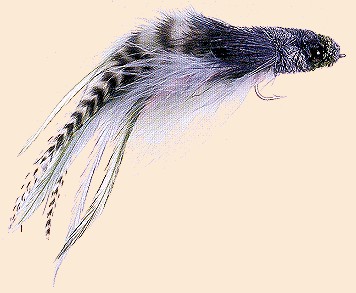
 |
|
Tinker Mackerel
Previously published in the
Fly Fishing New England magazine. We thank them for sharing
this with our readers. |
|
2. Tie on a green maribou, a pink maribou, and
a blue maribou feather to represent the shoulder.
 3. Tie on two green saddle hackles back to back, streamer style.
 4. Tie on two blue saddle hackles, streamer style.
|

5. Tie a grizzly saddle hackle along both sides of wing.
 6. Tie on a big bunch of blue dyed deer body hair with the tapered ends facing towards the rear.
 7. & 8. Tie on a second bunch of body hair and a pair of crystal eyes colored with orange marker.
|

9. Tie on a bunch of green body hair.
 10 & 11. Tie on a final bunch of blue body hair and trim head to shape. 12. Go fishing!!! ~ Bill Catherwood
|
About Bill Catherwood: |
|
For more great flies, check out:
Beginning Fly Tying,
Intermediate Fly Tying and Advanced
Fly Tying.
|
[ HOME ]
[ Search ] [ Contact FAOL ] [ Media Kit ]

